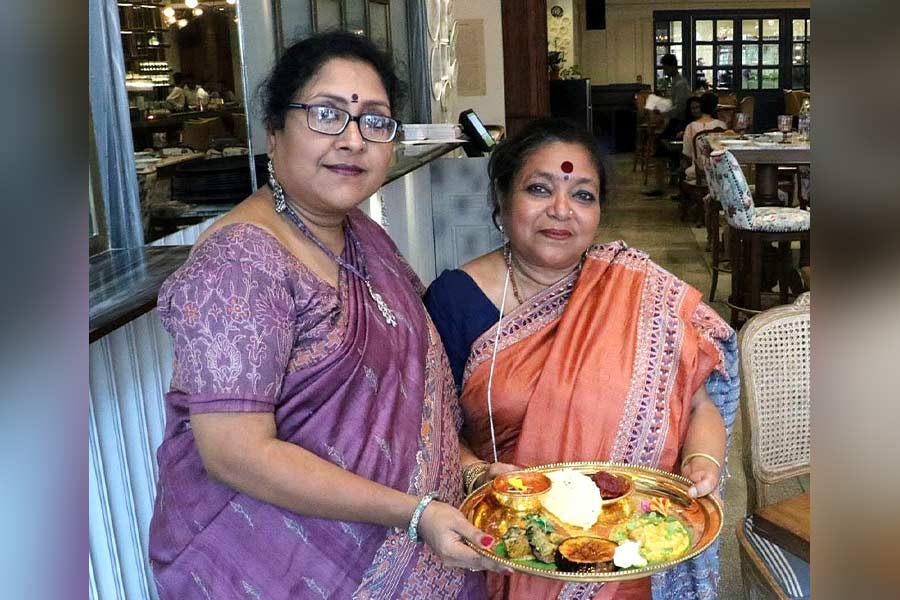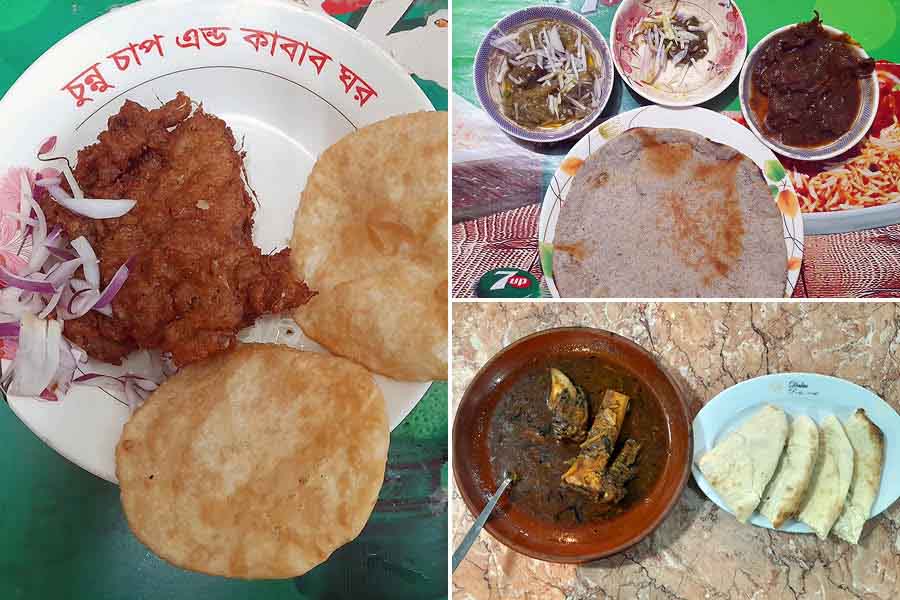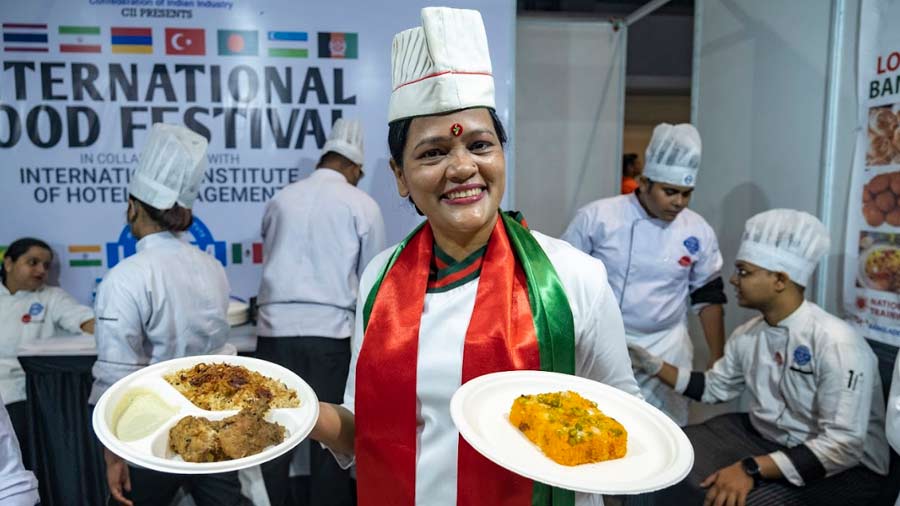Nayana Afroz lives in Dhaka, but spends months in Kolkata — for many restaurants serving Bengali cuisine in the city, Afroz is their guiding hand. For Bangladeshi food festivals, new menu launches and sometimes for her own food pop-ups, she travels to Kolkata often to impart her expert advice on Bangladeshi cuisine and train chefs.
For Afroz, simply serving food from Bangladesh is not the goal, it is about bringing the authenticity, culture and origin of the food to people. “My food tells stories. Stories of the people of Bangladesh, its history and culture,” said the chef.
Currently in the city to work hand-in-hand with Babu Culture’s chefs to present Banglar Padabali, a special menu featuring dishes from four districts of Bangladesh from July 5 to 16, Afroz spoke to My Kolkata about her journey.
Bridging the gap with food
A telephone cross-connection led Nayana Afroz (formerly, Nayana Sengupta) to the love of her life. An ex-student of Modern High School and resident of south Kolkata, she moved to Dhaka, Bangladesh, after marriage. Although both sides of the border called themselves Bangali, there was a cultural difference that the newly wedded daughter-in-law had to bridge, and her journey to immerse in the culture of her new home began with food. “I learnt cooking Bangladeshi food, initially, from my landlady whom I called Khalamaa. She taught me how to make bhortas like loitya shutki bhorta and many other specialities of Chittagong like khaisya — fish cooked with broad bean seeds,” said Afroz recalling her early days in Dhaka.
Cooking shows became her other sources of knowledge on Bangladeshi food. “I used to make a lot of snacks that I learnt from watching cooking shows. I had notebooks where I jotted down numerous recipes from these shows. Later, when I started working with developmental sector in Bangladesh, I was introduced to different food and traditional cooking methods while I visited remote villages across districts,” she said.
Afroz had to speak to women in the villages for her job, but they would often refuse to speak to her as they were busy with daily chores. So, she decided to join them in their daily tasks, including cooking, and that slowly got her acceptance with the community, and unknowingly her culinary journey took root.
As she gained more knowledge on the food of opar Bangla, she found distinct differences and similarities in cooking technique and the use of ingredients. “For example, you don’t see much use of onion and garlic when cooking hilsa in India. But in Bangladesh, hilsa is cooked in various ways and there are countless preparations of hilsa where onion and garlic is used. For example, in bhortas, ilish korma etc. It’s the same for certain vegetables. In West Bengal, small leafy vegetables are mostly vegetarian but in Bangladesh, these are cooked with small fish or prawns. Another difference is that Bangladeshi food in general is more spicy and oily,” explained Afroz.
The similarities, on the other hand, are in the meat dishes and says, “The chicken and mutton gravies are cooked similarly, with mostly the same ingredients. The tempering used in dals — onions, dried red chillies, etc.— are used.”
Social media to dining halls

Chef Nayana Afroz began her journey in food curation with (right) food historian Pritha Sen in 2014 Courtesy Nayana Afroz
Afroz always had a knack for cooking, and her husband and immediate family members became her food tasters, while friends and followers on social media admired the food with their eyes. It was through social media that her journey into commercial kitchens began.
“I used to cook at home and post photos on my Facebook account and then on different food groups. Around 2009, Pritha di (food historian and revivalist Pritha Sen) approached me and made me one of the admins of her food group. There she asked me to share authentic recipes and food stories from Bangladesh. Later in 2017, she approached me for a 10-day pop-up in Mumbai's Mustard. I was overjoyed but hesitant because I had no experience of cooking in a commercial kitchen. But she insisted and we did the pop-up on the food of undivided Bengal. We divided the menu and did that together, and it was super successful. Some of the dishes I made were haate makha moosuri dal, tehari, beetroot halwa, papaya halwa.”
Soon after Mustard, Afroz was invited to curate a menu at The Taj Mahal Palace, Mumbai, and she has not looked back since then. She trained in restaurants in Mumbai, Delhi and Bengaluru and did successful pop ups in various cities and the food was appreciated by patrons. In fact, at one of her recent events, actor Chunky Panday indulged himself to four helpings of her taheri. “He was very sweet and enjoyed the food thoroughly. When someone told him to stop, he said that he wanted to but he couldn't because he loved the food so much,” Afroz recalled, smiling.

Chef Nayana Afroz with actor Chunkey Panday in Mumbai Courtesy Nayana Afroz
In Kolkata she has worked with restaurants like Aheli, Swissotel, 6 Ballygunge Place, and more, for pop-ups and food festivals. At 6 Ballygunge Place, she hosted a Bhorta festival in 2023 where she presented bhortas like Til-Badam Bhorta and Tishi Balachao Bhorta. She is also behind the Opare Banglar Ranna menu at Epare Bangla restaurant in Lake Terrace. The menu features dishes like Dal Chingri Bhorta, Gota Roshun Er Murgi, Ilish er Haate Makha Shorisha Jhal, Methi Boal, Shyaka Kumror Bhorta and more.
Back in Dhaka, Afroz runs a cloud kitchen from her home from where she serves pop-out menus during special occasions.
History and tradition, on a plate
Nayana Afroz thrives on authentic Bangladeshi food and her aim is to serve Bangladeshi food beyond the stereotypes. “Talk about Bangladeshi food, and people will tell you about Kachhi Biryani or Ilish Pulao. But Bangladeshi cuisine is much more than that. It includes a variety of vegetarian dishes, big and small fish and dishes that are specialities of certain districts. There is Faridpurer chapila do pyaza, Sylhet shatkora khashi, Dhakai mutton tehari and more. When I curate a menu, I make sure there is something new or unconventional that people would only experience in Bangladesh.”
When asked about the resurgence of bhorta in the culinary scene, Afroz said that the popularity actually dates back almost to a decade, when people thought that Bangladeshi food was all about different bhortas. “I chose to showcase Bangladeshi food with bhorta dishes at 6 Ballygunge Place as people can easily relate bhortas and Bangladesh.”
Authenticity plays a major role in the menus that the culinary expert curates. “In this age of food vlogging and recipe content creation, authenticity is often lost. A trend emerges and people follow it without verifying anything. For example, a simple ilish lej bhorta is named as Mawa Ghat er ilish lej bhorta. But how will you make that in Kolkata? The bhorta is made with a pickle oil made by the people in Mawa Ghat. If you can’t get that oil, it is not Mawa Ghat er ilish lej bhorta because the speciality of that dish is missing.”
When asked if she would like to write a recipe book or open her own restaurant in Kolkata or Dhaka, she reckons those plans are a few years away stil. l“As long as I am working with restaurants and training the chefs, I don’t want to do either of the two. I want people to understand the cuisine deeply and gain knowledge. My restaurant will be a small venture where people will experience the wonders of the cuisine, but if I train chefs, we can reach a larger audience. The recipe book can be done after some years when I take a break,” she said.
This July, Nayana Afroz has curated a menu at Babu Culture with dishes from Khulna, Rajshahi, Rangpur and Barishal. On the menu are Meherpurer Ilish Khichudi, Jhenaidaher Khashir Mangsho Diye Buter Dal, Khulnar Amra Diye Dim Amoya, Meherpurer Deshi Kurgir Jhol, Barishal er Ilish Malai and more. The menu will be available at all outlets in Kolkata.




